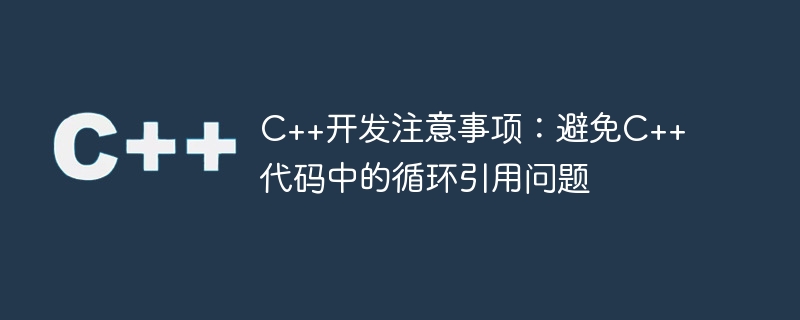

C is a widely used programming language that is widely used in various fields such as game development and embedded system development. In the C development process, there is a common problem called the "circular reference" problem. Circular reference refers to two or more classes referring to each other, forming a circular reference relationship. This situation can lead to compilation errors or runtime errors and make the code unmaintainable. This article will introduce the precautions to avoid circular reference problems in C development.
First, understand what a circular reference is. Circular references usually occur when there is a bidirectional pointer or reference relationship between classes. A circular reference occurs when two classes refer to each other. For example, class A and class B refer to each other, and the code is as follows:
// ClassA.h
#include "ClassB.h"
class ClassA {
ClassB* b;
};
// ClassB.h
#include "ClassA.h"
class ClassB {
ClassA* a;
};In the above code, class A contains a pointer to an object of class B, and class B contains a pointer to an object of class A. . A circular reference is formed between these two classes.
Circular references can cause a series of problems. First, it causes compilation errors. During the compilation process, the compiler will compile each file in sequence according to the inclusion relationship. When compiling ClassA, it will try to include the ClassB.h file, but the ClassB.h file will try to include the ClassA.h file, thus forming a circular inclusion. relation. This will put the compiler into an infinite loop and eventually lead to compilation errors.
Secondly, circular references can also cause runtime errors. When two classes reference each other, problems can arise in the object's constructor and destructor. For example, when an object of class A is destructed, it will call the destructor of class B, and the destructor of class B will call the destructor of class A, thus forming an infinite loop of destructor calls. . This can exhaust the program's memory and produce runtime errors such as segfaults or stack overflows.
In order to avoid circular reference problems, some measures need to be taken. First, you can use forward declaration to resolve circular references. Forward declaration tells the compiler that a certain class exists, but does not contain the specific definition of the class. For example, instead of including the ClassB.h file directly, you can use the forward declaration of Class B in ClassA.h, as shown below:
// ClassA.h
class ClassB; // forward declaration
class ClassA {
ClassB* b;
};In this way, ClassB.h does not need to be included when compiling ClassA file, thus avoiding circular reference problems.
Secondly, you can use smart pointers to manage memory, thereby avoiding the explicit use of raw pointers. Smart pointers can automatically manage the life cycle of objects and automatically release memory when the object is no longer referenced. Commonly used smart pointers include std::shared_ptr and std::unique_ptr. Using smart pointers can avoid memory leaks and infinite loop destructor calls caused by circular references.
In addition, if two classes really need to reference each other and the circular reference problem cannot be solved through forward declaration, you can consider using design patterns such as the Observer Pattern or Dependency Injection. . These patterns can help minimize coupling between classes, thus avoiding circular reference problems.
In short, circular references are a common problem in C development and can cause compilation errors and runtime errors. In order to avoid circular reference problems, we can use methods such as forward declarations, smart pointers, or design patterns to solve them. Through reasonable design and programming, the occurrence of circular reference problems can be avoided and the maintainability and readability of the code can be improved.
The above is the detailed content of C++ Development Notes: Avoiding Circular Reference Problems in C++ Code. For more information, please follow other related articles on the PHP Chinese website!
 What are the differences between c++ and c language
What are the differences between c++ and c language
 Recommended learning order for c++ and python
Recommended learning order for c++ and python
 Cost-effectiveness analysis of learning python and c++
Cost-effectiveness analysis of learning python and c++
 Is c language the same as c++?
Is c language the same as c++?
 Which is better to learn first, c language or c++?
Which is better to learn first, c language or c++?
 The difference and connection between c language and c++
The difference and connection between c language and c++
 C++ software Chinese change tutorial
C++ software Chinese change tutorial
 Cost-effectiveness analysis of learning python, java and c++
Cost-effectiveness analysis of learning python, java and c++




